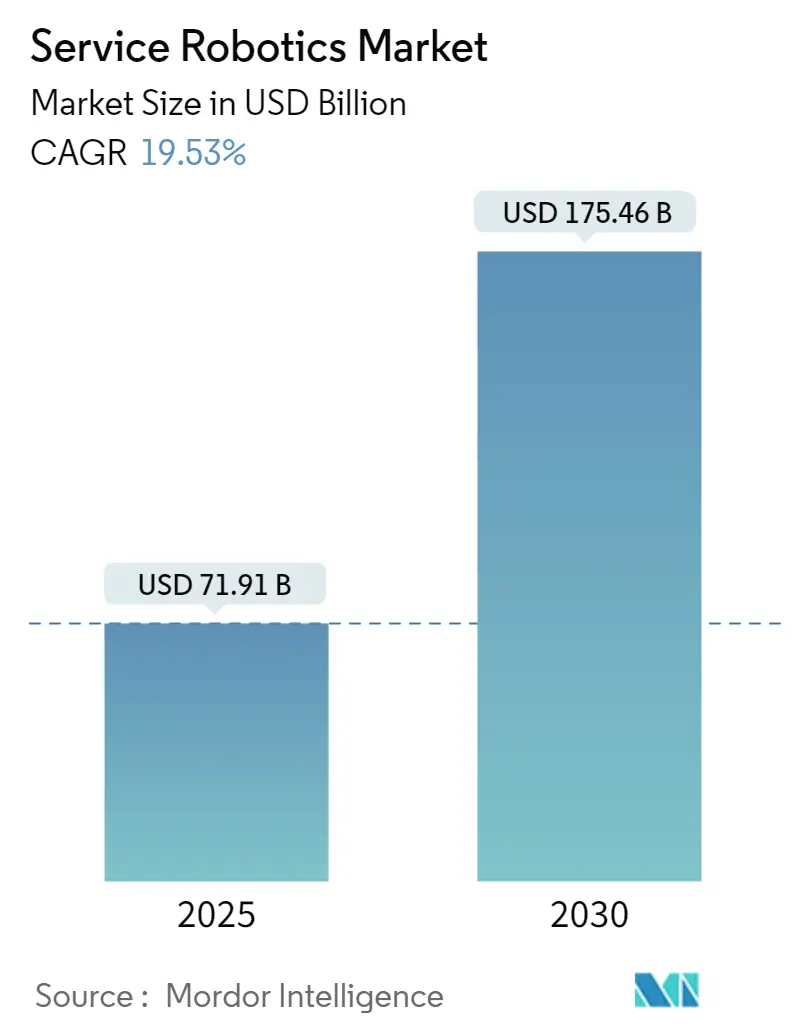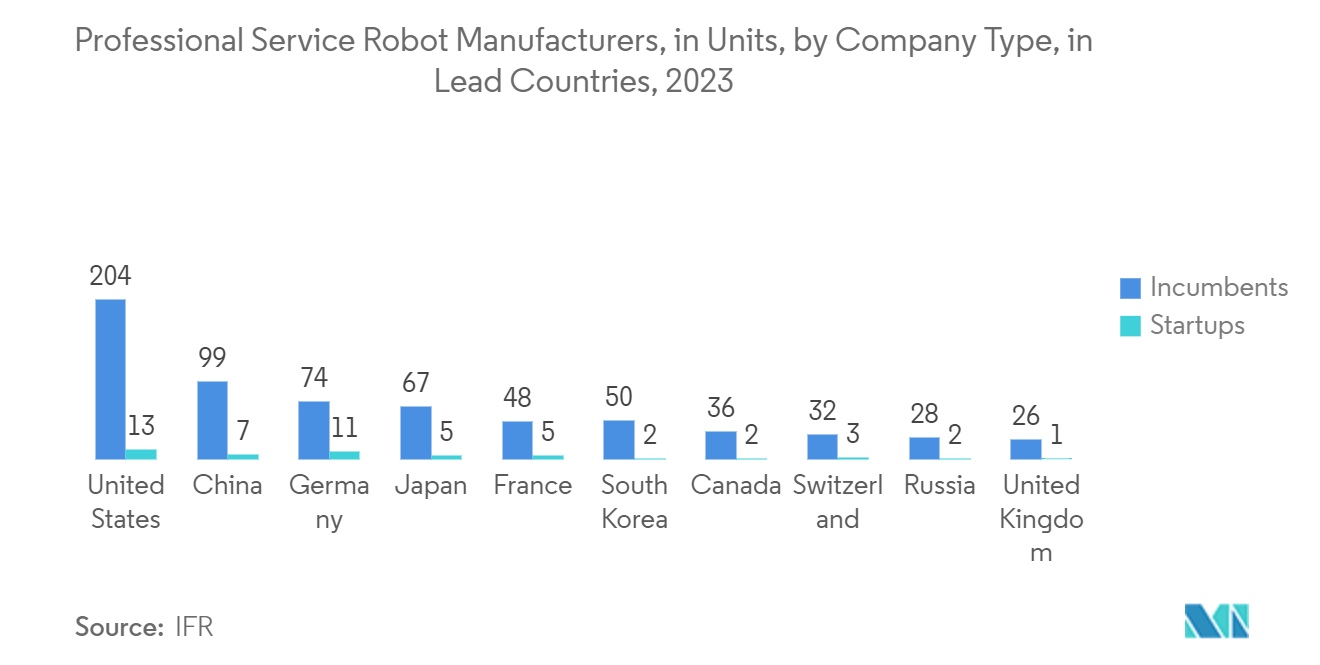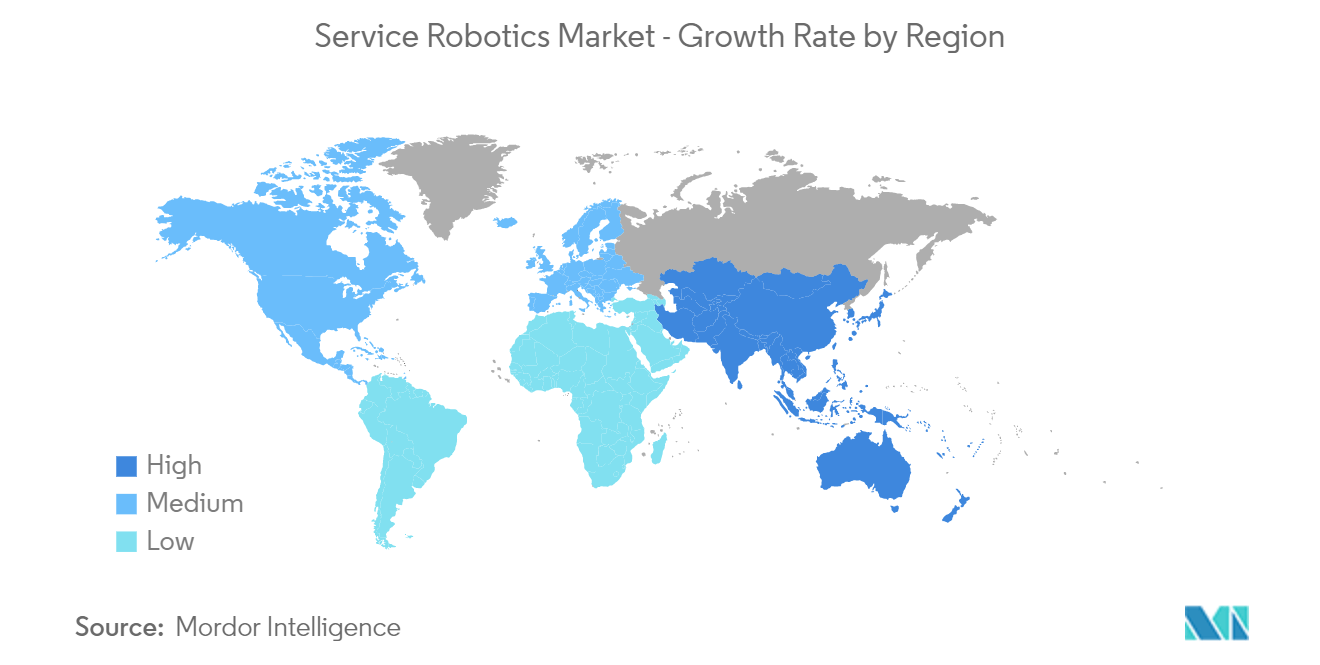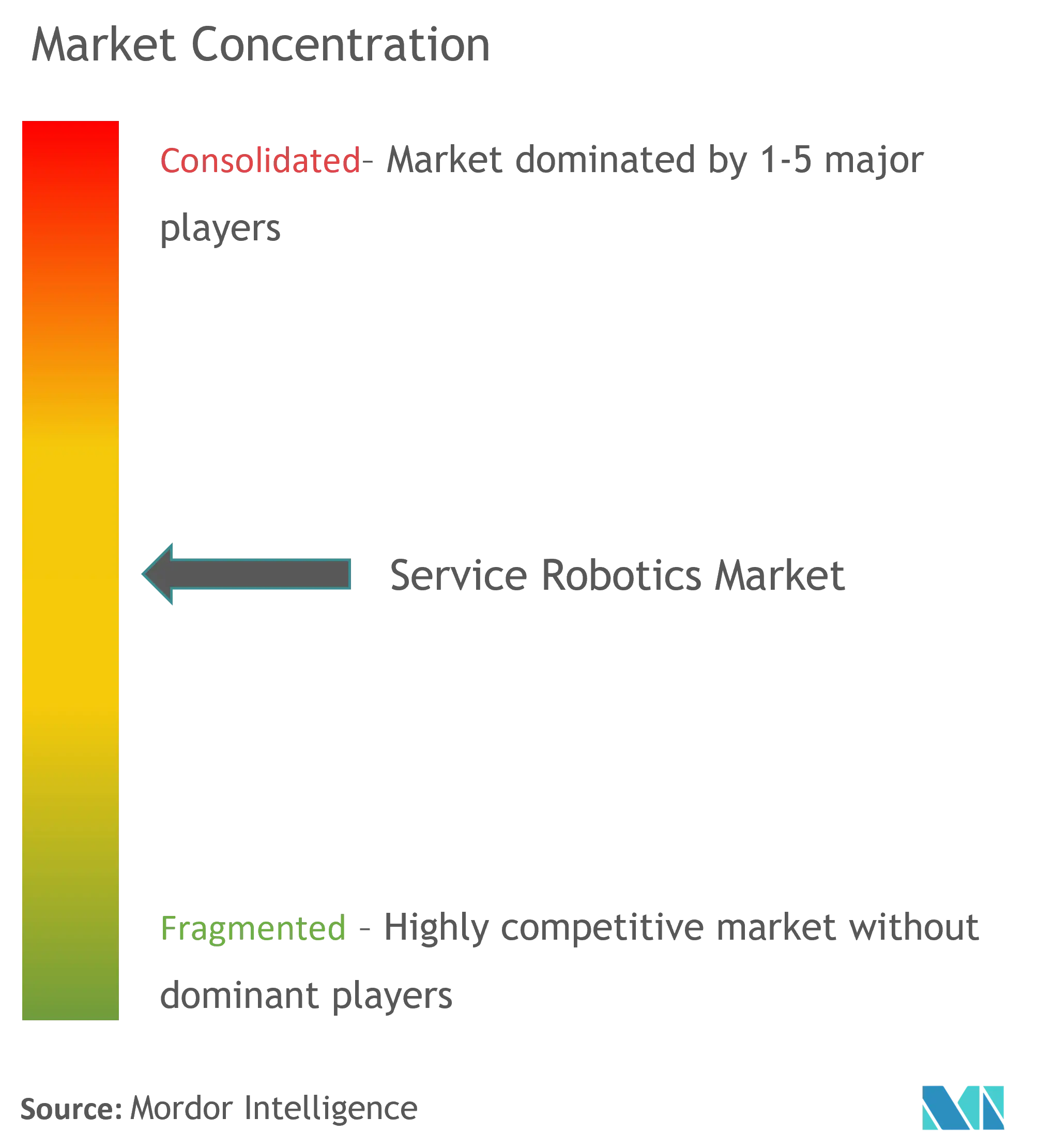Service Robotics Market Analysis
The Service Robotics Market size is estimated at USD 71.91 billion in 2025, and is expected to reach USD 175.46 billion by 2030, at a CAGR of 19.53% during the forecast period (2025-2030).
Service robots offer several features, such as delivering precise and high-quality service and helping users reduce human mistakes and operational expenses, due to which their demand has increased. Additionally, the rapid proliferation of service robot capabilities owing to technological innovations is also among the key factors driving the market's growth.
- Service robots, both personal (for household, entertainment applications, etc.) and professional (for defense, security, medical assistance, etc.), are gaining significant popularity as technological improvement and the development of affordable robots have significantly enhanced their penetration among general consumers. According to data from the International Federation of Robotics (IFR), sales of professional service robots increased by about 37% in 2021.
- Technological innovations concerning cognition, interaction, and manipulation have made service robotics more appealing. Technology and other component providers have moved the robotics ecosystem forward. For instance, recently, ABB entered into a strategic partnership with Switzerland-based start-up Sevensense to enhance ABB's new Autonomus Mobile Robotics (AMR) offering with techn ologies such as artificial intelligence (AI) and 3D vision mapping.
- The aging population of several countries, including Japan and China, is also driving the growth in the medical technology sector, thus, creating a massive market for service robotics in the region. For instance, according to the Japanese government's data released in September 2022, for the first time, Japan's over 75s accounted for over 15% of the population. Such trends encourage companies to invest in products for the elderly, which is a massive opportunity for the service robot providers.
- Service robots are usually deployed for personal/household purposes, like vacuum and floor cleaning, elderly assistance, and entertainment. However, several vendors have now started exploring new cases and are focusing on designing robots to perform tasks, such as delivering food and drinks to customers at hotels and airport lounges, handling check-in and check-out services at hotels, and even carrying luggage, which is boosting the demand for service robots.
- However, the factors such as low awareness, especially in developing regions, and the higher cost of service robots are challenging the growth of the studied market. Furthermore, a certain degree of technical know-how is also required to operate these robots, which is a significant challenge for the market's growth.
Service Robotics Market Trends
Professional Use of Robots to Account for a Significant Share in the Market
- Professional robots consist of field robots, defense, and security robots, medical assisting robots (MAR), public assistant robots, electrical industry robots, and robots for construction purposes. The increasing penetration of digital technologies and automation solutions across these sectors drives the demand for professional robots.
- For instance, service robots are deployed in the construction industry to overcome heavy labor costs, shortages, and accidents. It also helps construct more reliable buildings since there is less chance of human error. Technologies like 3D printing and demolition robots further act as catalysts in adopting robots in the construction sector.
- Exoskeleton robots are used as public relations robots. Most public relations robots are used to assist customers in finding an item or completing a task. These robots are deployed in retail to guide customers around a store and in the hospitality industry, banks, shopping malls, family entertainment centers, and more.
- Major application areas for professional robots are transportation, hospitality, medical, professional cleaning, and agriculture. Transportation was among the leading consumer of professional robots in the aforementioned year. For instance, according to IFR, in 2023, the United States boasts the largest number of professional service robot manufacturers, significantly surpassing the combined count of China and Germany, its closest competitors. Notably, leading nations, including the United States, see a robust presence of robotics startups, challenging the dominance of established firms.
- Service robots are used in medical and healthcare for various applications, including diagnostic systems, robot-assisted surgery or therapy, rehabilitation systems, etc. The outbreak of the COVID-19 pandemic played an important role in driving the demand for robots across the sector. For instance, according to IFR 2021, a 23% growth in the sales of medical robots was recorded in 2021, with the number of shipments touching 14,823 units.
Asia Pacific to Exhibit a Significant Growth Rate
- The Asia Pacific is one of the fastest-growing regions in the world, owing to the presence of a large consumer base, among which the demand for service robots is increasing, especially in countries such as China, Japan, South Korea, and India, among others. For instance, according to IFR, in 2021, the sales of professional robots grew by about 30% in Asia.
- Regional governments are also a significant factor in developing a regional robotics market. For instance, India plans to invest in military robotics, and the country is preparing to deploy advanced robotic soldiers in the next few years. This is evident from the fact that in January 2022, the All India Robotics Association (AIRA) announced the beginning of indigenous manufacturing of defense robots.
- A similar trend has been observed across other countries of the region as well. For instance, the Chinese government has ambitious plans for the country's robotics industry. The government has listed the robotics industry, along with artificial intelligence (AI) and automation, as one of the priority sectors for high-end development to push forward the transformation and upgradation of the manufacturing industry. This push is expected to raise the global market share of Chinese-made robots.
- Further, financial services companies in Asia are looking to streamline costs to boost dividends to shareholders, maintain profitability, and have a new tool at their disposal that appeals to customers, for example, service robots.
- Some major countries, such as Japan, China, etc., are also witnessing significant growth in the aged population. According to the estimation of UN DESA and the National Bureau of Statistics of China (NBSC), the percentage of the population aged 60 and above is expected to grow to about 38.81% by 2050. Such trends are expected to drive the demand for service robots in the country.
Service Robotics Industry Overview
The Service Robotics market is moderately consolidated, as major players have a significant market presence. However, with the demand growing, new players are also entering the market, driving competition and the market toward a fragmented stage. Vendors are adopting various strategies to consolidate further their market presence, including product innovation, partnerships, acquisitions, etc. Some major players include Daifuku Co. Ltd, Dematic Corp., Swisslog Holding AG, and iRobot Corporation.
In September 2022, Avidbots, a robotics company based in Canada, raised USD 70 million in the Series C funding round. The company primarily develops autonomous cleaning robots and has built Neo 2, a robotic floor cleaner designed for commercial environments such as warehouses, airports, and shopping malls.
In September 2022, Jacky's Business Solutions, a leading B2B technology solutions provider, announced a showcase of its latest iteration of Temi Robot (V3) at the Gitex event. The company launched this new personal assistance robot in the Middle East with Robot-as-a-service (RaaS) business model.
Service Robotics Market Leaders
-
Daifuku Co. Ltd
-
Dematic Corp.
-
Swisslog Holding AG (KUKA)
-
Omron Corporation
-
iRobot Corporation
- *Disclaimer: Major Players sorted in no particular order
Service Robotics Market News
- June 2024 - Brick Hospitality, a prominent hospitality management company based in San Diego, has responded to the rising need for efficient guest services by incorporating guest service robots across all its hotel operations. Notably, it stands out as the hotel management group to deploy these robots across its entire portfolio.
- April 2024 - Pudu Robotics, known for its service industry robots, has expanded into the industrial domain with the PUDU T300. The T300 boasts exceptional maneuverability, enabling it to navigate tight industrial spaces effortlessly. Setting it apart from its counterparts, this robot is equipped with a map-and-go function, eliminating the need for constant network connectivity. Moreover, its IoT features encompass secure door access, elevator control, and advanced navigation, facilitated by a suite of lidar and depth cameras.
Service Robotics Industry Segmentation
As per the International Organization for Standardization, a service robot performs functional tasks for humans or equipment, excluding industrial automation applications. The market is broadly segmented into professional and personal robots. Besides, the study also encompasses segmentation by Geography (North America, Europe, Asia-Pacific, and the Rest of World). The report offers market forecasts and size in value (USD) for all the above segments.
Professional service robots automate time-consuming, menial, or repetitive tasks, allowing human workers to achieve more intellectual functions. On the other hand, personal service robots are consumer-facing robots for automating tasks, mainly at home. This could include things such as autonomous vacuum cleaners or window cleaners.
| By Field of Application | Professional | Field Robots | |
| Professional Cleaning | |||
| Inspection and Maintenance | |||
| Construction and Demolition | |||
| Logistics Systems (Manufacturing and Non-manufacturing) | |||
| Medical Robots | |||
| Rescue and Security Robots | |||
| Defense Robots | |||
| Underwater Systems (Civil/General) | |||
| Powered Human Exoskeletons | |||
| Public Relation Robots | |||
| Personal/Domestic | Robots for Domestic Tasks | ||
| Entertainment Robots | |||
| Elderly and Handicap Assistance | |||
| By Geography | North America | ||
| Europe | |||
| Asia | |||
| Australia and New Zealand | |||
| Latin America | |||
| Middle East and Africa | |||
Service Robotics Market Research FAQs
How big is the Service Robotics Market?
The Service Robotics Market size is expected to reach USD 71.91 billion in 2025 and grow at a CAGR of 19.53% to reach USD 175.46 billion by 2030.
What is the current Service Robotics Market size?
In 2025, the Service Robotics Market size is expected to reach USD 71.91 billion.
Who are the key players in Service Robotics Market?
Daifuku Co. Ltd, Dematic Corp., Swisslog Holding AG (KUKA), Omron Corporation and iRobot Corporation are the major companies operating in the Service Robotics Market.
Which is the fastest growing region in Service Robotics Market?
Asia Pacific is estimated to grow at the highest CAGR over the forecast period (2025-2030).
Which region has the biggest share in Service Robotics Market?
In 2025, the Asia Pacific accounts for the largest market share in Service Robotics Market.
What years does this Service Robotics Market cover, and what was the market size in 2024?
In 2024, the Service Robotics Market size was estimated at USD 57.87 billion. The report covers the Service Robotics Market historical market size for years: 2019, 2020, 2021, 2022, 2023 and 2024. The report also forecasts the Service Robotics Market size for years: 2025, 2026, 2027, 2028, 2029 and 2030.
Our Best Selling Reports
Service Robotics Industry Report
The Global Service Robotics Market is on a remarkable growth trajectory, driven by the rising adoption of service robots across diverse sectors such as healthcare, logistics, agriculture, and retail. This surge is attributed to technological advancements, including IoT and AI integration, which are significantly enhancing robot capabilities. Robotics companies are leading the charge, developing affordable and precise service robots to meet the increasing demand across various industries. The market benefits from a shift towards automation, aiming to reduce human intervention in industrial operations.
Despite challenges like high initial costs and data privacy concerns, the market's future looks promising, especially with efforts to improve humanoid robots' user interface and communication for more interactive operations. According to Mordor Intelligence™ Industry Reports, the service robotics market is witnessing a substantial growth rate, with professional robots dominating the market share due to their widespread use in critical sectors.
For detailed insights and a market forecast, a free report PDF download is available, offering a comprehensive analysis and outlook on the service robotics market's future. The market size is expanding as industries seek innovative solutions to enhance efficiency and productivity. The global market is experiencing a significant transformation, driven by market trends that emphasize automation and technological integration.
The industry report highlights the market research conducted to understand the market segmentation and market value. The market analysis reveals that professional robots are leading the market due to their application in essential sectors. The market report provides an in-depth industry overview, showcasing the market leaders and their contributions to the market growth.
Industry analysis and industry information are crucial for stakeholders to understand the market dynamics. The industry outlook indicates a positive trajectory for the service robotics market, with industry reports and industry research supporting these findings. Industry sales and industry size are expected to grow as more sectors adopt service robots.
Market data and market predictions suggest that the market will continue to evolve, with new developments and innovations driving market growth. The market review emphasizes the importance of market segmentation in understanding the diverse applications of service robots. Market value is expected to increase as the demand for automation solutions rises.
In summary, the service robotics market is poised for significant growth, supported by technological advancements and increasing demand across various sectors. The report example and report PDF provide valuable insights for stakeholders, while research companies continue to explore new opportunities in this dynamic market.

.webp)





